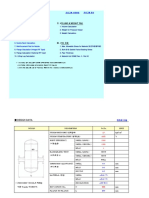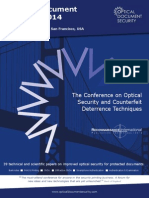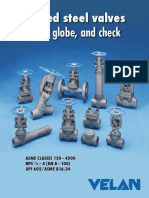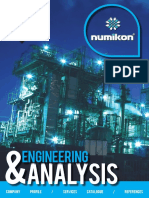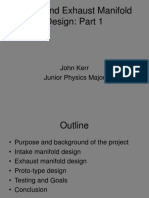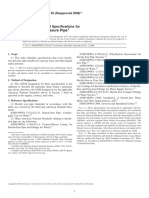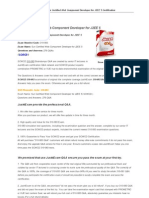Chien1995 PDF
Chien1995 PDF
Uploaded by
FelipeMorenoOriginal Title
Copyright
Available Formats
Share this document
Did you find this document useful?
Is this content inappropriate?
Report this DocumentCopyright:
Available Formats
Chien1995 PDF
Chien1995 PDF
Uploaded by
FelipeMorenoCopyright:
Available Formats
Determination of Steam Quality and Flow
Rate Using Pressure Data From an Orifice
Meter and a Critical Flowmeter
Sze-Foo Chien*, SPE, and James L. G. Schrodt, SPE, E&P Technology Dept..
Texaco Inc.
Summary b. The steam flow research facility, the orifice-choke experi-
A method for measurement of steam quality and flow rate has been ments, and the results.
developed, laboratory tested, and packaged for thermal EOR ap- c. And, an example of field application of the measurement sys-
plications. The method consists of an orifice flow meter in series tem and the benefits derived from the results.
with a critical flow meter. The flow through the orifice is subcritical. It should be emphasized that the information explicitly or implic-
The critical-flow meter can be a static choke, a venturi, a nozzle, or itly described in this paper is the basis of issued or pending U.S. pat-
a thick orifice, etc. Steam flow rate equations for orifice flow and ents.
for critical flow were established with empirically derived
constants. These two equations were combined and solved to deter- Principles of the Steam Flow Measurement System
mine the steam quality and flow rate. The concept of the present measuring system originated from the
The basic mechanical parts of the measurement system are fact that for a given steam pressure and flow condition, the steam
rugged and inexpensive. The pressure transmitters and flow com- flow rate and steam quality are related such that one can not be
puter are portable and can be used for spot checks or for continuous solved without the knowledge of the other. Therefore, two indepen-
monitoring. The steam quality and flow rate information obtained dent flow rate measurements must be employed to obtain data that
make it possible to evaluate the performance of steam distribution are needed to solve for both the steam quality and flow rate. Techni-
systems and thus to identify where modifications to the distribution cally, there are many possible flow measurement combinations. The
system piping are needed. choice becomes a compromise between cost, durability, ease of
installation and maintenance, adaptability to the existing steam dis-
Introduction tribution network, and the accuracy of the measurement. These con-
siderations lead to a method which is a combination of two basic
The design of a steam distribution network for a thermally enhanced flow-rate measuring devices: one to measure flow in subcritical
oil recovery (EOR) operation must not only meet the requirements flow and the other to measure the same flow in critical flow. The ori-
ofthe process conditions but should also deliver the desired quantity fice plate has been selected to measure the flow under subcritical
of heat to each injection well. Thermal EOR operations use wet flow while a choke, a venturi, a nozzle, a thick orifice, or an adjust-
steam which is a mixture of saturated liquid and saturated vapor. The able choke can be used to measure the flow under critical flow. In
percentage, by mass, of saturated vapor in the wet steam is known this paper, the discussion is focused on a system using a standard
as steam quality. Because steam is a two-phase fluid, the determina- choke as the critical flow meter. This system is designated as the ori-
tion of the flow rate is a more complicated matter. Furthermore, be- fice-choke steam flow measurement system. A schematic diagram
cause the heat content of saturated vapor differs from that of the sat- of the system is shown in Fig. 1. It should be noted that one may re-
urated liquid, the heat content per unit mass of wet steam is verse the arrangement of these two meters. However, critical flow
dependent on the steam quality. Therefore, to determine the quantity generally results in a significant change in the thermodynamic state
of heat injected, both the steam quality and flow rate must be known. of steam downstream of the choke. Therefore, an additional equa-
A convenient method for steam flow measurement can provide the tion, such as heat balance equation, would be required to solve for
opportunity to analyze and optimize injection heat rates. This paper the additional unknown in such an arrangement.
presents a laboratory and field proven method to determine both the
steam quality and flow rate in a steam distribution network and thus Critical Flow Choke Equation for Wet Steam. Many steam injec-
the distribution of heat energy to the reservoir. tion wells for shallow EOR reservoirs use a critical flow choke to
The development of the present method began in 1986 1. The mea- control injection flow rate. The advantage of using a choke or other
surement system consists of a standard orifice plate situated up- critical flow device is that the flow rate will remain constant regard-
stream of a critical flow device and uses static and differential pres- less of the change in the pressure downstream of the choke. There
sure measurements to compute both the steam quality and flow rate. are a number of equations that describe the critical flow rate of steam
The validity of this method was proven during field testing in Ba- 3. The form of the flow equation adopted in this work is one pro-
kersfield, CA2. The development continued at Texaco's Steamflow posed by Napier and modified by King and Crocker4,
Research Facility in Bellaire, TX to refine the design and pertinent
equations, to formulate computation programs for solving the equa- w =
dz. p
a - -b . ....•.......•.....•..•.......••.. (1)
(1~0)
tions, to package the system for field applications, and to investigate
the performance of various critical flow devices suitable for this
method. The measuring system has been available commercially
where w is the steam flow rate, de is the diameter of the critical flow
since 1989 and has been installed on more than 1500 injection wells meter, p is the pressure, and X is the steam quality. The value of a
for a host of thermal EOR projects worldwide. and b in Eq.l are to be determined from experimental data to cali-
This paper describes: brate for a particular critical flow device, flow regime and pressure
a. The analytical development and basic principles of the mea- range.
surement system, the pertinent equations, and the numerical method
used to solve for the steam quality and flow rate. Orifice Flow Equation for Wet Steam. The orifice flow equation
is an adaptation of the general orifice flow equation, i.e.,
Copyright 1995 SOCiety of Petroteum Engineers
Original SPE manuscript received for review Oct. 4, 1992. Revised manuscript received Dec.
12, 1994. Paper accepted for publication Aug. 12, 1994. Paper (SPE 24832) first presented w= . ................. (2)
at the 1992 SPE Annual Technical Conference and Exhibition held in Washington, Oct. 4-7.
76 SPE Production & Facilities. May 1995
Differential
Pressure
Taps
PiP~harp-Edged Orifice Plate
~ \ I Static
a:!M~~ Make-up
Water
Gas
\ / Pressure
Steam
From
Supply
Line
To Injection Well C1 Condensor E1 Heat Exchanger Pl Feedwater
01 Generator Feed Drum G1 Steam Generator Pump
Fig. 1-0rifice-choke steam flow measurement system. 02 Steam Separator H1 Adjustable Choke P2 Centrifugal
03 Flash Drum Ml Steam Mixer Pump
04 Steam Separator M2 Steam Oesuper- ~ Control Valve
where do is the orifice diameter, ~ is the ratio of orifice diameter/ heater
pipe diameter, <j> is the orifice pressure drop, vexp is the two-phase
Fig. 2-Schematic diagram of the test facility.
specific volume of the steam as it flows through the orifice, and Co,
Fa , and Y2 are the discharge coefficient, thermal expansion coeffi-
cient, and vapor expansion coefficient, respectively. These coeffi- I
cients are calculated according to MillerS.
The mathematical form of vexp used in Eq.2 is as proposed by F' (X) =
B (L)B-I_ 2b K:L (ttot- (7)
100 A p2 vfga 2
James 6,
and then the value of X is calculated according to:
B
v exp = A(vfg ) c~o) + vf , ••••..•..••••.•....•.. (3) XII + I Xn F(X II )
100 = 100 - F (XII)' ............................ (8)
where X is the steam quality, Vfg is the specific volume of vaporiza-
tion, and Vf is the specific volume of saturated liquid. The steam The iterative procedure continues until the value of X converges.
properties, Vfg and Vf, can both be expressed as functions of the steam Generally, the iteration process will take no more than 5 times to ob-
pressure 7 . The values of A and B in Eq.3, which differed from those tain a value within 0.1 %. However, it should be mentioned that Eq.4
determined by James, are established experimentally for a specified may have more than one root. It is a good practice to initiate the it-
range of steam pressure and flow regime. eration process from X=]OO and select the higher value among the
roots. Once the value of the steam quality is determined, the steam
Numerical Method to Solve the Simultaneous Equations. The flow rate can be calculated according to either Eq.1 or Eq.2.
steam quality and flow rate can be determined by simultaneously
solving the equations presented above. Replacing vexp in Eq.2 by Description of the Steam Flow Research Facility and
Eq.3 and equating it to Eq.!, results in: the Orifice-Choke Experiments
The Test Facility. The experimental facility is shown schematically
in Fig. 2. De-ionized water stored in the generator feed drum (D-I)
is transferred by a positive displacement feedwater pump (P-l) to
0, .............. (4)
the natural gas fired 12MM Btu/hr steam generator (G-I). The steam
produced by the generator has a steam quality generally in the 50%
where to 80% range. It is separated into its vapor and liquid constituents
in the inlet separator (D-2). The desired mass rate of saturated vapor
K = (1888.56 Co Fa
1 _f34
yi (do)4
d, ................... (5)
for a specific test condition is taken from the vapor stream. It is mea-
sured by an orifice meter and controlled by a control valve prior to
entering the vapor-liquid mixer (M-I). Vaporfrom the separator is
Note that in Eq.4 the only information required is the pressure drop also used as a heat source for the heat exchanger (E-I), that preheats
across the orifice plate and the static pressure between the orifice the liquid to near equilibrium conditions, before the liquid stream
and the choke. A, B, a, and b are constants to be established by ex- enters the mixer. Excess vapor and liquid effluent from the separator
periments for the range of operating conditions (i.e., pressure, flow (D-2) are flashed through control valves and sent to the flash drum
regime, etc.) and type of flow meter. (D-3) which operates at a lower pressure.
To solve values of X in Eq.4, for measured values of p and <j>, a A high speed, high pressure centrifugal pump (P-2) transfers de-
numerical iteration method, such as the Newton-Raphson, is used. sired quantity ofliquid from the flash drum (D-3) to the mixer (M-I)
This method is performed by setting for mixing with the vapor stream from the inlet separator. The liquid
flow rate is measured by an orifice meter and controlled with a con-
2b
trol valve. The liquid temperature is raised to near equilibrium
F(X) = (L)B_K:L (I~O) + ~ (6)
condition with vapor phase in the heat exchanger (E-I) before enter-
ing the mixer (M -I). The quality of steam entering the test section
100 A p2 vfga 2 vfgA
is calculated by a heat and mass balance on the liquid and vapor
and by differentiation of Eq. 6 with respect to X, streams entering and leaving the mixer.
SPE Production & Facilities, May 1995 77
0.035
i- 'ij,
0.0301- i-
I 0.7 -
~ol?:0.025 I-
a;
CD l- " >
S?
0.5 - -
E 0.020 I- .....
~
<U If· ~
c- -
C- o
JIl .:- c.
)(
CD Q)
0.3 I- 0 -
'Q. 0.015 - ... ~
<U
z '0
CI>
::J
t
~ 0.2 -
~
0.01011.-_ _ _ _-L_ _ _..L...._-l._..l-.......JI....-.l.-...I.-............
%
10 20 30 50 70 100
Measured Steam Quality, Percent
o
Fig. 3-Experimental value of Napier's parameter vs. measured 'ib
steam quality. 0.1 ..l. ..l.
10 20 30 50 70 100
Measured Steam Quality, Percent
After leaving the mixer, steam flows through a straight entrance
length of approximately 41 feet of 2-in. schedule 80 pipe before en- Fig. 4-Experimental value of (vexD - Vt)/Vta vs. steam quality.
tering the test section. Steam from the test section flows through
approximately 10 ft of2-in. pipe and then enters the steam separator The Experimental Results
(D-4). The liquid and vapor streams from the separator are mea- The measured data includes orifice diameter, do; choke-bean size,
sured by orifice meters to determine their flow rate and steam quali- de; static pressure, p; orifice differential pressure, <p ; steam flow
ty. After the measurement, the liquid stream is flashed through a rate, w; and steam quality, X. These data are used to determine the
control valve and sent to the flash drum (D-3). The vapor stream values of a, b,A, andB for a specific flow regime and pressure range.
from the separator flows through an adjustable choke to reduce its
pressure to 30 psig and then mixed with a liquid stream from the Critical Flow. The choke flow data are correlated as Napier's Pa-
flash drum in the desuperheater (M-2). From the de superheater the rameter 3 , (de 2p )/w, and plotted against steam quality, X, as shown in
mixture is condensed and cooled to approximately 180°F in a Fig. 3. Note that this plot is on a logarithmic scale which will help
double bay air condenser (C-I) and then sent to the generator feed to establish the value ofaand b for Eq.!. Similar curves but of slight-
drum (D-I) to complete the cycle. Iy different slope are obtained for the critical flow data of other criti-
The entire facility is insulated with a thick layer of calcium sili- cal flow devices.
cate and covered with a 1/16-in. corrugated aluminum skin for
weather protection. Pressure, temperature, level, and flow measur- Subcritical Flow Through Orifice. To determine the value of A
ing and transmitting devices are situated at strategic locations of the and B for a prescribed steam pressure range the quantity, (vexp -
facility to control and to monitor the operation of the test facility. Vj)/Vfg, is plotted versus steam quality, X, on a logarithmic scale. An
example of the test results is shown in Fig. 4. The value of vexp can
The Experiments. The test loop is a 2-in. schedule 80 pipe with
!.94-in. I.D. Range of the test conditions are:
Steam pressure: 400 to 800 psig
Steam quality: 19% to 95%
Steam mass rate: 2,000 to 15,000 Ibmfhr
The test section, as shown in Fig. I, consists of an orifice and a
choke. Differential pressure of the orifice is measured across the ori- C 80
CI>
fice and static pressure is measured between the orifice and the u
(jj
choke. C-
The flow meters tested included: ~
Subcritical Flow Meter: (ij 60
::J
Sharp-edged Orifice a
diameter - 1.0 and 1.25 in. E
ct!
Critical Flow Meter: CI>
Choke U5 40
'C
bean sizes - 20/64, 24/64, 28/64, and 32/64 in. CI>
length - 6 in. ~
::J
Venturi U
(ij 20
throat size - 20/64, 24/64, and 32/64 in. 0
length - 3 to 15 throat diameters
cone angle - 3 to 15°
Thick Orifice (bullet, jet, and drilled hole perfs.)
diameter - 114 in.
thickness - 3/8 in.
Adjustable Choke
needle and seat type (3/4-in. seat) Fig. 5-Calculated steam quality vs. measured steam quality.
78 SPE Production & Facilities, May 1995
20,000..-----..-- IlrT.j.,----,
1 -...-,-,.--1',-,..- 1.0
..c=, 0.9
E =: venturi
:£ 10,0001- ,g
m- I-
O.S
ro I- "iii
u
OC 7,0001- ~
=: I- 0
~ 5,0001- - '0 0.7
::J
~ I- - ....a.
m "0 0.6
Ci5
"0
3,0001- - a.
Q)
choke
1§
::J
u
2,000 - 0.5
(ij
o
0.4
20 40 60 80 100
1,000L_ _.JIL--.J1L..lI~I~L:-~~.I-fI~I~_~:-:. Steam Quality %
1,000 2.000 3,000 5,0007,00010,000 20.000
Measured Steam Flow Rate, Ibm/hr Fig. 7-Downstream to upstream pressure ratio of critical flow
VS. steam quality.
Fig. 6-Calculated flow rate VS. measured flow rate.
and meter run data, and selects the logging interval and mode. The
be calculated from the measured flow rate, orifice pressure drop, flow computer averages the pressure data, calculates the steam qual-
orifice and pipe size,and calculated value of COFa Y2 according to: ity and mass rate, and displays, prints, and stores a record ofthe mea-
surement. The system can be used for spot check measurements or
v exp
= (1883.3556C o F"Y2 )2 d
w2
! . ..................
4
I_/-,4
(9) for longer duration continuous monitoring.
The method described above has been used on over 1300 steam
injectors in the Kern River field in Bakersfield, CA. Critical flow
The values of CoFa Y2 for the entire test range fall in a rather narrow
chokes were already in use on each of the injection wells to control
range and can be taken as a constant as long as the steam pressure,
flow rate. Installation of an orifice meter upstream of the choke was
choke bean and orifice sizes are in the range of this study.
all that was required for the application of this method. The orifice-
choke meter runs are permanently installed on each injector. Five
Steam Quality. By introducing the values of orifice and choke di-
portable measurement systems consisting of transmitters and a flow
ameter, measured pressure, and differential pressure into Eq.4,
computer mounted on a pickUp truck, as shown in Fig. 8, are com-
steam quality, X, can be solved using the method described above. missioned to measure the steam quality and flow rate. A field techni-
The calculated qualities for the test are shown against the measured cian, with the portable unit, can perform up to 20 measurements per
quality in Fig. S.lt shows that the calculated values are within a stan- day.
dard deviation of four quality points of the measured values. The measured steam injection data along with the well location
data allows the construction of distribution maps of steam quality,
Steam Flow Rate. The steam flow rate can be calculated according flow rate, and heat rate for a project area. For example Figs. 9, 10,
to Eq.1 or Eq.2 using the calculated steam quality. Results are and 11 show the average steam quality, flow rate, and heat rate dis-
plotted against the measured steam flow rate in Fig. 6. The calcu- tribution maps, respectively for a project consisting of 21 injectors
lated flow rates agree quite well with the measured flow rates. The in an area of approximately 75 acres. Steam distribution maps offer
difference between the calculated and the measured steam flow the reservoir or production engineer a method to identify portions
rates, for the entire test range, are within a standard deviation of of the reservoir which are not receiving recommended steam injec-
4.75%. tion rates. Steam injection data combined with knowledge of the
Use of Other Critical Flow Meters. Critical flow chokes are attrac-
tive for steam flow rate control because of their low cost, ease of use,
and immunity to the change in downstream pressure. The disadvan-
tage is that approximately 50% of the steam pressure is lost to
achieve critical flow.
For cases where steam pressure must be conserved, a critical flow
venturi, an adjustable choke, or a convergent-divergent nozzle can
provide the same advantages as the critical flow choke while requir-
ing as little as 15% pressure drop. The diverging diffuser of these
devices recovers a part of the pressure which was lost in accelerating
to critical flow condition. The upstream to downstream pressure ra-
tio of a critical flow, Pd Ipu, is plotted as a function of steam quality
for both the choke and venturi in Fig. 7.
Field Application of the Measurement Method
To facilitate the field application of the described method, the mea-
surement system has to be portable, easy to operate, and able to dis-
play and store the measured and computed results. The system that
was devised consists of a pair of flexible braided metallic pressure
hoses, covered with insulation, that are used as impulse lines to con-
nect the static and differential pressure transducers, using quick-
connects, to the taps on the meter run. The operator inputs the well Fig. 8-Truck mounted transmitters and flow computer.
SPE Production & Facilities. May 1995 79
• The key equations and a numerical method for their solut.ion
were presented.
• The empirical coefficients in the equations are derived from ex-
perimental data for the range of steam flow conditions and for the
100 type of critical flow device used.
90 • The orifice-choke meter run is an inexpensive and durable rate
controlling element which is a standard component of each steam
80
injection wellhead.
70 • For cases where injection pressure must be conserved, an ap-
propriate, low pressure drop critical flow device such as a venturi
60
should be used.
• The measurement system, consisting of pressure transmitters
and a flow computer, is portable, easy to operate, and is able to re-
cord short or long term measured and computed results.
• The orifice-choke system is able to measure steam quality with-
in a standard deviation of 4.0 steam quality points and a flow rate
standard deviation of 4.75% of the flow rate.
• Field application of this measurement system has demonstrated
its capability to improve the overall performance of thermal EOR
projects.
Acknowledgments
o
The authors would like to thank Texaco Inc. for the permission to
Fig. 9-Steam quality distribution in a project area. publish this paper and to acknowledge the contribution by J. A. An-
derson, E. W. Chandler, R. N. Hodges, Jr., C. F. Perdue, M. T. Ru-
bel, lR. Stoy, and J. W. Scott in conducting the experiments of this
piping layout of the steam distribution network will allow facilities
work.
engineering to make modifications to piping system as necessary to
improve steam distribution.
Nomenclature
Field application of this method has the following benefits on
steamflood operations: a,b= Parameters involved in critical flow equation
• Savings in fuel costs can be realized by avoiding over-injection A,B= Parameters involved in vexpequation, Eq. 3
and production can be increased by diverting the excess heat where Co=Orifice discharge coefficient
it's needed. dc = Diameter of the critical flow meter, in.
• Recovery can be improved in areas where oil would have been do = Orifice diameter of the subcritical flow meter, in.
left behind, due to under-injection, by insuring proper heat delivery. F(X)= Function of X as defined in Eq. 6
• Simulation model and field pilot studies can be improved by us- F(~,)= Function F(X) with X = Xn
ing more accurate field data resulting in improved recovery from F'(X)= Derivative of function F(X) with respect to X
thermal EOR projects. F'(~,) = Derivative of function F(X) with X = Xn
Fa= Thermal expansion coefficient of an orifice
Results and Conclusions
K= Function as defined in Eq. 5
p= Pressure between subcritical & critical flow meters,
A method for the measurement of steam quality and flow rate has psi a
been developed and the benefits of its use described. Pd= Pressure downstream of critical flow meter, psia
The Steam Flow Measurement System described consists of the Pu= Pressure upstream of critical flow meter, psia
following features: v exp = Experimental specific volume in the orifice flow
• A meter run, consisting of an orifice meter in subcritical flow equation as defined in Eq. 3, ft 31lbm
in series with a critical flow meter, such as a choke, venturi, or ad- Specific volume of the saturated liquid, ft 3/lbm
justable choke. Specific volume of vaporization, ft 3/lbm
....
6000 ~ ZOO
:::l
ro
'0 160
c:
til
<J)
:::l
16 0
0
.c:
r- 1 40
m
(=3 12 0
a:
c: 10 0
.Q
tl SO
Cll
E
caOJ
J:
o
Fig.1o-lnjection nite distribution in a project area. Fig. 11-Heat rate distribution in a project area.
80 SPE Production & Facilities, May 1995
w = Steam flow rate, Ibmlhr SI Metric Conversion Factors
X= Steam quality, percent (quality points) Btu x 1.055 056 E+OO =kJ
X" = nth iteration of X value, percent (quality points) ft x 3.048* E-OI =m
X" + 1= (11 + I)th iteration of X value, percent (quality points) in. x 2.54* E+OO =cm
Y2 = Vapor expansion coefficient calculated according to Ibm x 4.535 924 E-OI =kg
orifice downstream pressure psi x 6.894 757 E-03 =MPa
f3 = Beta ratio = orifice diameter I pipe diameter, fraction "Conversion factor is exact. SPEPF
1> = Differential pressure across the orifice, psi
References Sze-Foo Chien recently retired from Texaco Inc. in Houston,
I. Redus, C. L., et. al.: " Method of Determining the Quality of Steam for where he was a research consultant in the E&P Technology
Stimulating Hydrocarbon Production", U.S. Patent No. 4836032, June 6, Dept. He had been with Texaco Research since 1961. His re-
1989. search focus was in rheology, fluid mechanics and heat transfer
2. Redus, C. L., et. al.: "Kern River Field Test of a Steam Quality Measure- of multiphase and non-Newtonian fluids and recovery of un-
ment Technique," paper SPE 17445, 1988. conventional energy resources. He is an honorary professor at
3. Chien, S. F.: "Critical Flow Properties of Wet Steam," paper SPE 25804 the U. of Petroleum, Shangdong, China. Chien holds a BS de-
presented at the 1993 SPE IntI. Thermal Operations Symposium, Bakers- gree from Nat!. Taiwan U. and MS and PhD degrees from U. of
field, Feb. 8- 10. Minnesota, all in mechanical engineering. James L G, Schrodt
4. King, R. C. and Crocker, S.: "Piping Handbook." McGraw-Hili, New is a project scientist at Texaco's E&P Technology Dept. in Bell-
York City (1967) 3.59-3.61. aire, TX, where he has worked since 1982. He earned a BS in
5. Miller, R. W.: "Flow Measurement Engineering Handbook," McGraw- chemistry from Louisiana State U. in 1980, and an MS in petro-
Hill, New York City (1983). leum engineering from the U. of Houston in 1983. He has worked
6. James, R. :"Metering of Steam-Water Two-Phase Flow by Sharp Edged on the development of steam flow technology since 1987 and
Orifices," Proc., Inst. Mech. Eng., (1965) 180, pt. I, n. 23, 549-566. was involved in the design and construction of Texaco's Steam
7. Chien, S. F.: "Empirical Correlations of Saturated Steam Properties," Flow Research Facility. Photo unavailable.
SPERE (May 1992) 295.
Chien
SPE Production & Facilities, May 1995 81
You might also like
- 강도계산프로그램Document16 pages강도계산프로그램심판자No ratings yet
- Optical Document Security 2014Document8 pagesOptical Document Security 2014Anastasiya AlexandrovaNo ratings yet
- Cause and Effect Matrix 316Document1 pageCause and Effect Matrix 316abdullah sahib50% (2)
- Manual Fujitsu General LimitedDocument32 pagesManual Fujitsu General LimitedSergio100% (3)
- Design Guide For Multi-Hole RO Plates With N 3 Holes: February 2016Document27 pagesDesign Guide For Multi-Hole RO Plates With N 3 Holes: February 2016Enrique RieraNo ratings yet
- Biogas Flow Meter Thermal PDFDocument7 pagesBiogas Flow Meter Thermal PDFManufacturer VerifyNo ratings yet
- Slurry Pipeline Design Approach Betinol NavarroDocument13 pagesSlurry Pipeline Design Approach Betinol Navarrovaldemarborges6929No ratings yet
- Fisher LP-Gas Regulators and Equipment Application Guide d450104t012Document87 pagesFisher LP-Gas Regulators and Equipment Application Guide d450104t012Alfredo Castro FernándezNo ratings yet
- Properties of AirDocument4 pagesProperties of AirRhea FayeNo ratings yet
- HSV86 PDFDocument48 pagesHSV86 PDFMohamed El MaadawyNo ratings yet
- TES-ME-STRTN-GL Design and Fabrication of Butt-Welded Transition Joints Specification (CAN-US-MEX)Document19 pagesTES-ME-STRTN-GL Design and Fabrication of Butt-Welded Transition Joints Specification (CAN-US-MEX)BetoCostaNo ratings yet
- Catalogo Valvulas Forged Velan PDFDocument36 pagesCatalogo Valvulas Forged Velan PDFCarlosEduardoMorenoManceraNo ratings yet
- Manual 341 DDocument142 pagesManual 341 DMiguel Angel Diaz GuzmanNo ratings yet
- Brochure - Modular Mud Tank 500 BblsDocument3 pagesBrochure - Modular Mud Tank 500 BblsHassan SleemNo ratings yet
- A Model For Gas-Liquid Slug Flow in Horizontal and Near Horizontal TubesDocument11 pagesA Model For Gas-Liquid Slug Flow in Horizontal and Near Horizontal TubesEugene CommerellNo ratings yet
- Orifice Plate Showing VenaDocument6 pagesOrifice Plate Showing VenahugepotatoNo ratings yet
- SUP-LUGB-C Vortex Flowmeter DatasheetDocument10 pagesSUP-LUGB-C Vortex Flowmeter DatasheetĐỗ Đức KiênNo ratings yet
- Air and Flue Gas Ducts and Dampers Data Sheet - ADocument1 pageAir and Flue Gas Ducts and Dampers Data Sheet - Ajkhan_724384No ratings yet
- CMBA-20-W7-DWG-002-00 - Rev.A - GENERAL ARRANGEMENT DRAWING FOR INSTRUMENT AIR RECEIVER (3-05-D05) - ModelDocument1 pageCMBA-20-W7-DWG-002-00 - Rev.A - GENERAL ARRANGEMENT DRAWING FOR INSTRUMENT AIR RECEIVER (3-05-D05) - Modelfauzy2504No ratings yet
- Gas Pressure Regulator HON 277 Hi-Flo™: Product InformationDocument8 pagesGas Pressure Regulator HON 277 Hi-Flo™: Product Informationmike.stavrianakos2717No ratings yet
- U-Tube Heat ExchangerDocument9 pagesU-Tube Heat Exchangerhirenpatel_62No ratings yet
- Steam Trap Datasheet TLV Type P65SRNDocument2 pagesSteam Trap Datasheet TLV Type P65SRNAnonymous ThzA9zNo ratings yet
- Ansi b109 Procedures 2016Document38 pagesAnsi b109 Procedures 2016Víctor Pérez0% (1)
- IbrDocument5 pagesIbrSuresh Ram RNo ratings yet
- Standard BS 1042 - Part 1 - 1964Document116 pagesStandard BS 1042 - Part 1 - 1964MPChethan100% (2)
- Numikon Katalog 2019Document42 pagesNumikon Katalog 2019mih1No ratings yet
- Steam Tracing AppendixDocument13 pagesSteam Tracing AppendixAmin BagheriNo ratings yet
- ANZ Technical Guide Heat Exchanger DesigDocument13 pagesANZ Technical Guide Heat Exchanger DesigvikramNo ratings yet
- Lonergan Part NumberingDocument1 pageLonergan Part NumberingRamiro OfratzerNo ratings yet
- Presentación de Normas de BombasDocument18 pagesPresentación de Normas de BombasP_I_P_HNo ratings yet
- IIT-Intake and Exhaust Manifold DesignDocument28 pagesIIT-Intake and Exhaust Manifold DesignVasudev GuptaNo ratings yet
- Liquid Monopropellant CombustionDocument4 pagesLiquid Monopropellant Combustionherdi sutanto adigunaNo ratings yet
- Hydraulic & Pneumatic Systems in Automotive VehiclesDocument2 pagesHydraulic & Pneumatic Systems in Automotive VehiclesWork WearautoNo ratings yet
- 3206 - RotameterDocument9 pages3206 - RotameterVidya MuthukrishnanNo ratings yet
- 14 Draw Off Nozzle Hydraulics PDFDocument12 pages14 Draw Off Nozzle Hydraulics PDFMohsin EhsanNo ratings yet
- Blowdown of Pipelines Carryng Flashing LiquidsDocument10 pagesBlowdown of Pipelines Carryng Flashing LiquidsMilson GomezNo ratings yet
- API 521 2020 Extract Hydraulic ReliefDocument6 pagesAPI 521 2020 Extract Hydraulic ReliefT. LimNo ratings yet
- E07 QDocument20 pagesE07 QSoledad Fernández SantosNo ratings yet
- Properties of Pure SubstancesDocument12 pagesProperties of Pure SubstancesDSNo ratings yet
- Calculate Mass Flow or Volumetric Flow For Any GasDocument2 pagesCalculate Mass Flow or Volumetric Flow For Any Gasvicbalt07No ratings yet
- 6206 Guide For Selection Installation andDocument32 pages6206 Guide For Selection Installation andakbavra80% (5)
- Turbine Vs OrificeDocument107 pagesTurbine Vs OrificePurwanto NugrohoNo ratings yet
- Index of Revisions: Material RequisitionDocument23 pagesIndex of Revisions: Material RequisitionLANKAPALLISURINo ratings yet
- Calculation of Orifice Plate Hole DiameterDocument3 pagesCalculation of Orifice Plate Hole DiameterhiuNo ratings yet
- API 682 Accumulator Data SheetDocument1 pageAPI 682 Accumulator Data SheetBhyrappaNo ratings yet
- CASTEL Brochure Safety Valves 3061 3065 - ENDocument4 pagesCASTEL Brochure Safety Valves 3061 3065 - ENAdrián Fernández AnduezaNo ratings yet
- Design of Fluid Systems PDFDocument66 pagesDesign of Fluid Systems PDFVirendra KumarNo ratings yet
- Sec.6 - Class C Heat ExchangerDocument33 pagesSec.6 - Class C Heat ExchangerAgung Dewandaru MahatmantoNo ratings yet
- Tutorialcaesarsii 130318231300 Phpapp01Document400 pagesTutorialcaesarsii 130318231300 Phpapp01Nayeem UddinNo ratings yet
- Sa-516 70 TDCDocument2 pagesSa-516 70 TDCshazan100% (1)
- Arts NPSH TutorialDocument3 pagesArts NPSH TutorialDidier SanonNo ratings yet
- PVC Pipe Making Machine 01 PDFDocument1 pagePVC Pipe Making Machine 01 PDFabdul kareeNo ratings yet
- Iso 10893 9 2011Document9 pagesIso 10893 9 2011basusonuNo ratings yet
- Procedure For Calculating Fuel Gas Saturated Lower Heating Value (SLHV)Document3 pagesProcedure For Calculating Fuel Gas Saturated Lower Heating Value (SLHV)Muhammad AsadNo ratings yet
- Checklist For Stress Analysis: PEC-EN-FRM-Y-08927Document1 pageChecklist For Stress Analysis: PEC-EN-FRM-Y-08927Yusri FakhrizalNo ratings yet
- FlowmetersinwetsupsteamDocument8 pagesFlowmetersinwetsupsteamqmet.solNo ratings yet
- Paper Velocity String SPE-30197-PADocument4 pagesPaper Velocity String SPE-30197-PAPablo RaffinNo ratings yet
- The Long Term Calibration Stability of Critical Flow Nozzles and Laminar FlowmetersDocument20 pagesThe Long Term Calibration Stability of Critical Flow Nozzles and Laminar FlowmetersSatit hunsaNo ratings yet
- Experiment 1 - Fluid Flow Measurements LDocument9 pagesExperiment 1 - Fluid Flow Measurements LClifford Dwight RicanorNo ratings yet
- Messner1982 PDFDocument18 pagesMessner1982 PDFanderlethNo ratings yet
- TS of Quad MooseDocument10 pagesTS of Quad MooseShivender PatialNo ratings yet
- SW41256 Flow of Synthetic Drilling Fluids 1999 MayDocument40 pagesSW41256 Flow of Synthetic Drilling Fluids 1999 Mayipixuna0% (1)
- 2015 - Experimental Characterization of Vertical Gas-Liquid Flow For Annular and Liquid Loading ConditionsDocument13 pages2015 - Experimental Characterization of Vertical Gas-Liquid Flow For Annular and Liquid Loading ConditionsEdson Orati da SilvaNo ratings yet
- (A) Morse Code and International Code of Flag SignalsDocument63 pages(A) Morse Code and International Code of Flag SignalsJohn Rey CastillanoNo ratings yet
- Canadian ASCR Code NamesDocument23 pagesCanadian ASCR Code NamesDay Geeaysky100% (1)
- Internship ReportDocument22 pagesInternship ReportMuhammad AsadullahNo ratings yet
- Ductile-Iron Pressure Pipe: Standard Index of Specifications ForDocument2 pagesDuctile-Iron Pressure Pipe: Standard Index of Specifications ForTamil funNo ratings yet
- Module 1 - Familiarization With Quantum GISDocument7 pagesModule 1 - Familiarization With Quantum GISRyan James AysonNo ratings yet
- Evolution of Operating SystemsDocument25 pagesEvolution of Operating SystemsPetra KumiNo ratings yet
- Chapter Rule of Thumb Daikin S Method Compatibility ModeDocument41 pagesChapter Rule of Thumb Daikin S Method Compatibility ModeMohamad Azizuddin100% (1)
- 310-083 SCWCD SUN Sun Certified Web Component Developer For J2EE 5Document9 pages310-083 SCWCD SUN Sun Certified Web Component Developer For J2EE 5Naveen AlluriNo ratings yet
- ILT 1500 DatasheetDocument2 pagesILT 1500 DatasheetcerconsNo ratings yet
- Deepak DSRDocument6 pagesDeepak DSRdeepakNo ratings yet
- Ra 7586Document10 pagesRa 7586Xymon BassigNo ratings yet
- 06 Flash and Fire PointDocument9 pages06 Flash and Fire PointanmarNo ratings yet
- Realisations Geodesiques PDFDocument46 pagesRealisations Geodesiques PDFArq CocoXochitl H CNo ratings yet
- W. Nyaigoti Omwoyo CVDocument5 pagesW. Nyaigoti Omwoyo CVWesley Omwoyo NyaigotiNo ratings yet
- Detail - Frame: Standard SymbolsDocument1 pageDetail - Frame: Standard SymbolsLallamaNo ratings yet
- ZXJ10 1Document25 pagesZXJ10 1Fahim Muhammad100% (1)
- (WWW - ChemistryABC.com) Physical PhotoChemistry (ChemistryABC) Sec PDFDocument50 pages(WWW - ChemistryABC.com) Physical PhotoChemistry (ChemistryABC) Sec PDFalienNo ratings yet
- K-II Report (English) 170108Document24 pagesK-II Report (English) 170108Tannum NegiNo ratings yet
- Labordental EnglischDocument64 pagesLabordental EnglischConstantin SturzaNo ratings yet
- Shot ListDocument2 pagesShot Listapi-341908436No ratings yet
- Project Management Professional Practice Quiz 1: Delphi TechniqueDocument6 pagesProject Management Professional Practice Quiz 1: Delphi TechniqueRavi SatyapalNo ratings yet
- Training Report On Orientation of Elderly SHGsDocument2 pagesTraining Report On Orientation of Elderly SHGsPayal SahaNo ratings yet
- Atwood Giuliani SchemaDocument15 pagesAtwood Giuliani SchemaAnonymous PDG3Hi2No ratings yet
- GCSE November 2021 FINALDocument29 pagesGCSE November 2021 FINALntktkinqNo ratings yet
- Product Handling Guide-FormaldehydeDocument4 pagesProduct Handling Guide-FormaldehydeBigbearBigbearNo ratings yet
- Beyond RTIm Towards Open GovernmentDocument6 pagesBeyond RTIm Towards Open GovernmentThavam RatnaNo ratings yet
- Solution-3678 Environmental Ethics in Built Environment Assgn 2Document44 pagesSolution-3678 Environmental Ethics in Built Environment Assgn 2M Hammad ManzoorNo ratings yet
